Setting goals is a critical component of professional growth and success. Examples of goals for work provide direction, foster motivation, and enable you to measure progress. However, not all goals are created equal. To be effective, goals should be SMART: Specific, Measurable, Achievable, Relevant, and Time-bound. In this article, we'll provide 10 detailed examples of SMART goals for work, guide you through creating effective SMART goals, and offer insights on measuring and tracking these goals.
What are Examples of Smart Goals for Work?
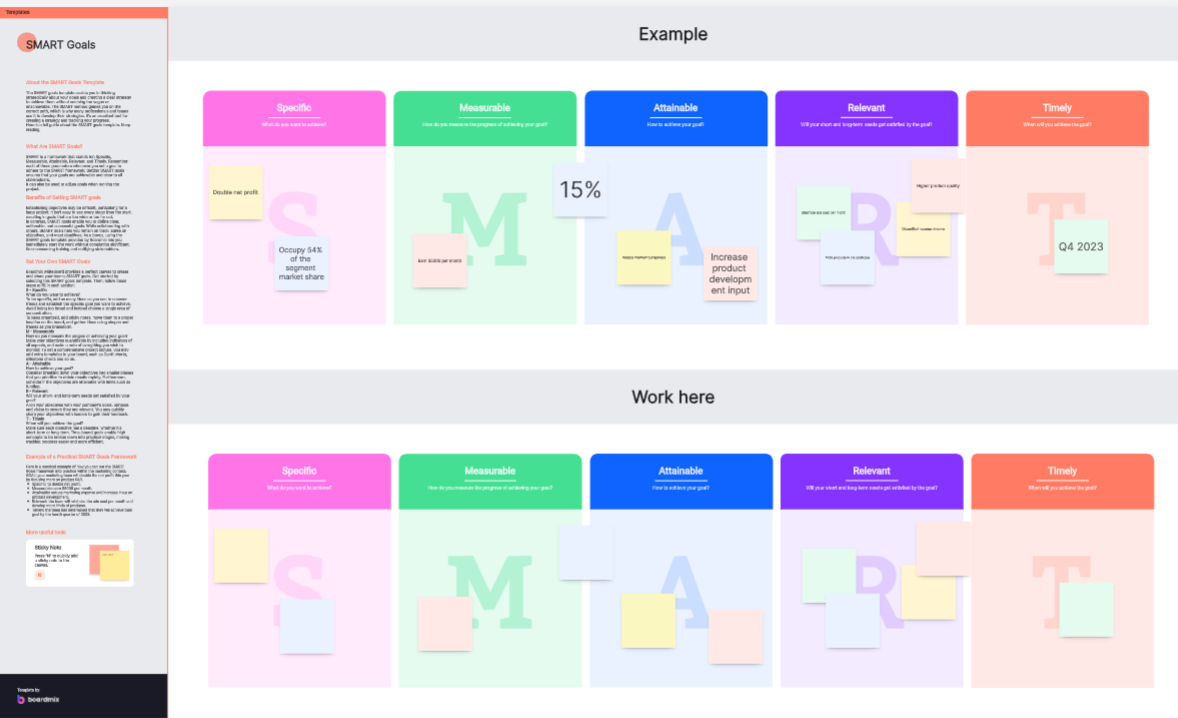
SMART goals are a structured way to set and achieve objectives that can significantly improve your performance at work. Each component of a SMART goal ensures clarity and feasibility, making it easier to stay focused and track progress. Here are some common categories where examples of goals for work can be applied in a work setting:
Professional Development: Goals aimed at enhancing skills or gaining new knowledge.
Performance Improvement: Targets for increasing productivity or efficiency.
Project Management: Objectives related to the successful completion of projects.
Team Collaboration: Goals to improve teamwork and communication.
Career Advancement: Aims to achieve promotions or new responsibilities.
10 Examples of SMART Goals for Work
Setting examples of SMART goals for work ensures that your objectives are clear, achievable, and aligned with your professional aspirations. Here are ten detailed examples of SMART goals for various aspects of work:
1. Professional Development
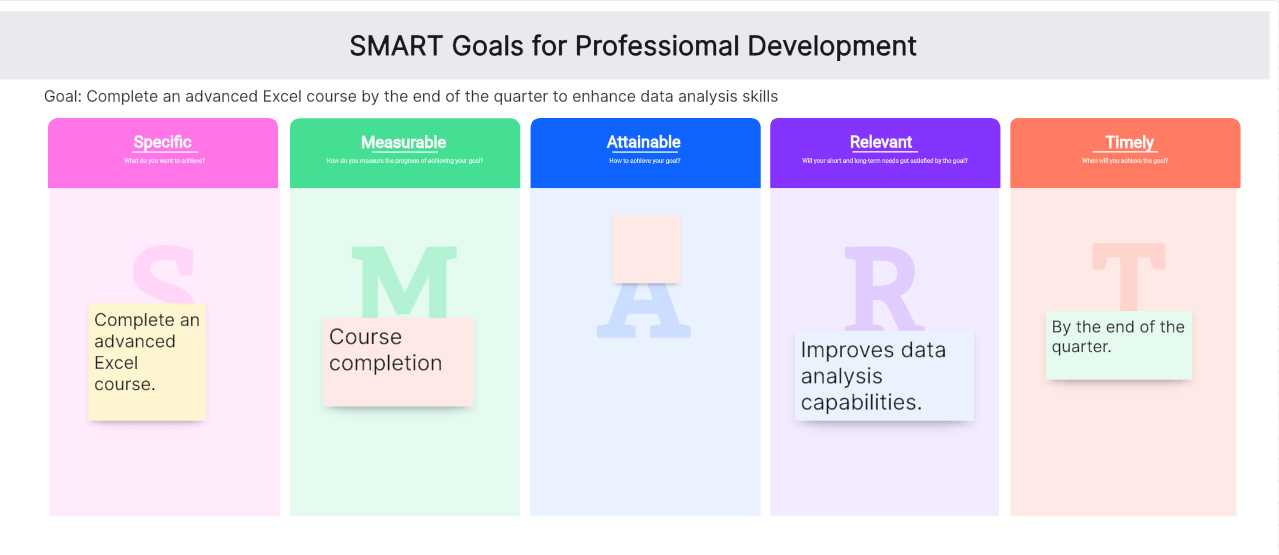
Goal: "Complete an advanced Excel course by the end of the quarter to enhance data analysis skills."
Specific: Complete an advanced Excel course.
Measurable: Course completion.
Achievable: Allocate 3 hours per week for the course.
Relevant: Improves data analysis capabilities.
Time-bound: By the end of the quarter.
2. Performance Improvement
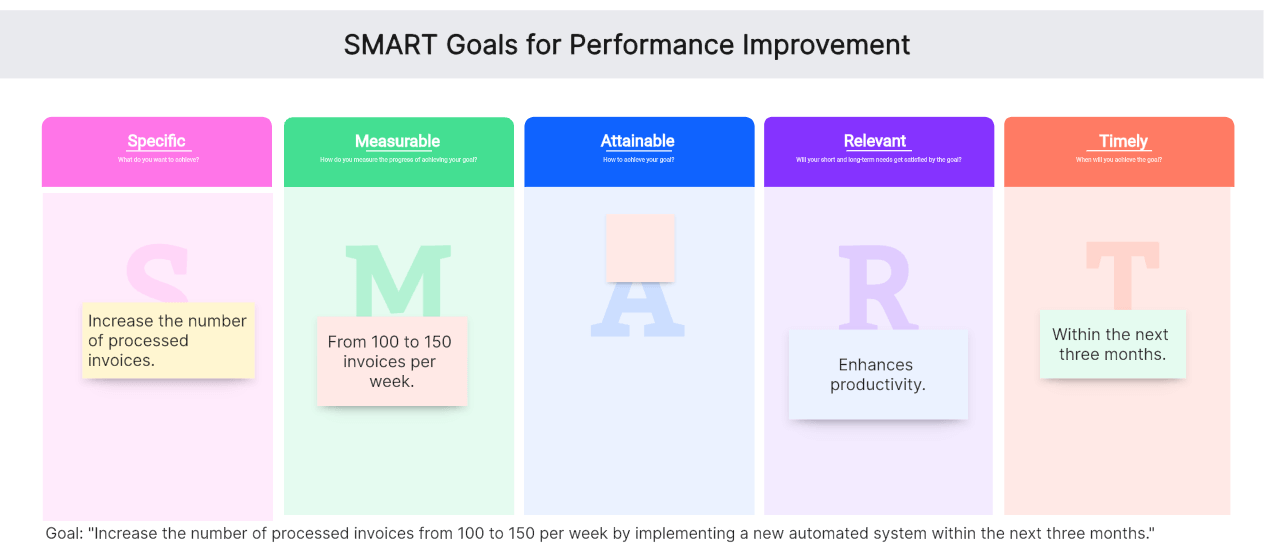
Goal: "Increase the number of processed invoices from 100 to 150 per week by implementing a new automated system within the next three months."
Specific: Increase the number of processed invoices.
Measurable: From 100 to 150 invoices per week.
Achievable: With the new automated system.
Relevant: Enhances productivity.
Time-bound: Within the next three months.
3. Project Management
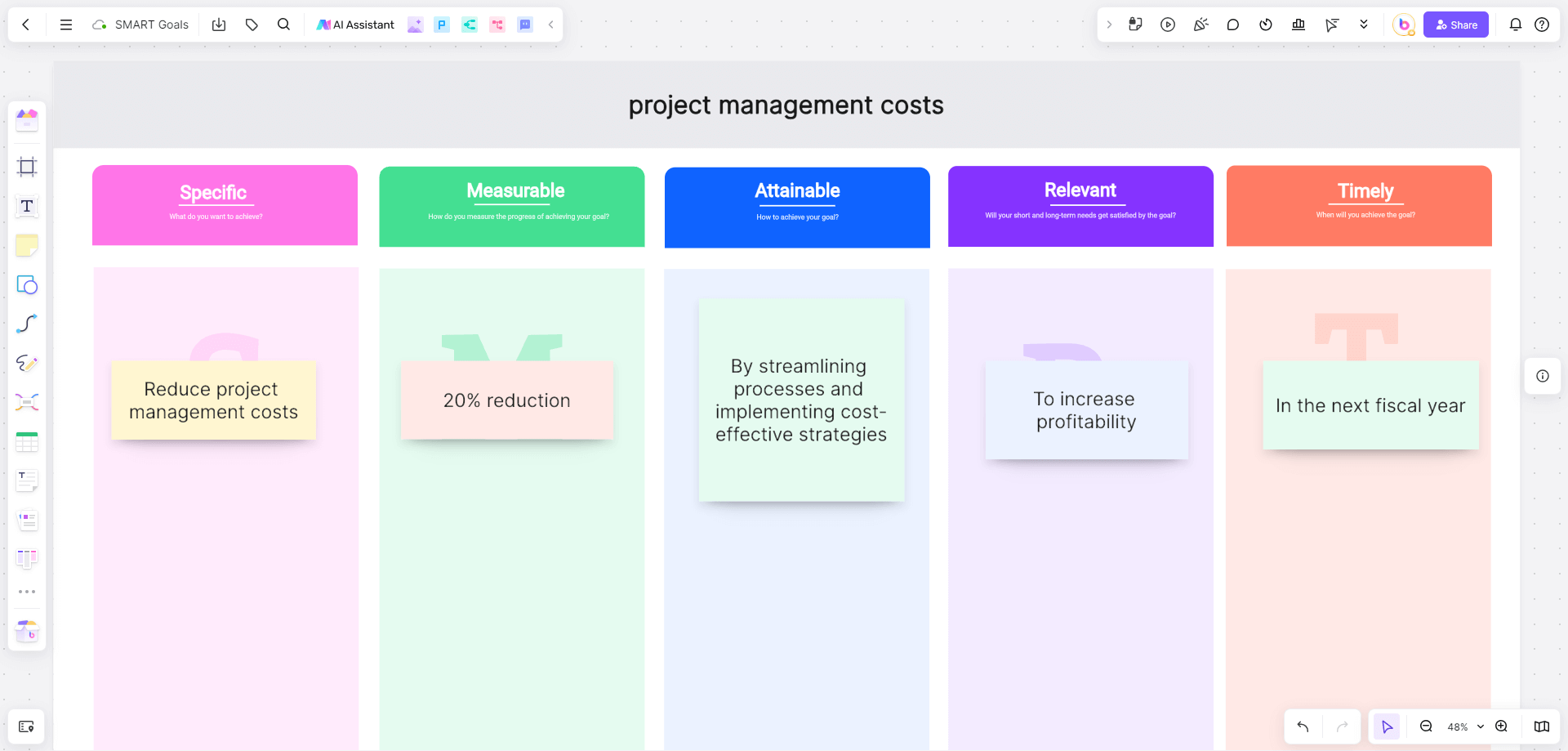
Goal: "Complete the client website redesign project by the end of Q2, ensuring all milestones are met on time."
Specific: Complete the client website redesign project.
Measurable: Milestones met on time.
Achievable: With a detailed project plan and resources.
Relevant: Directly impacts client satisfaction.
Time-bound: By the end of Q2.
4. Team Collaboration
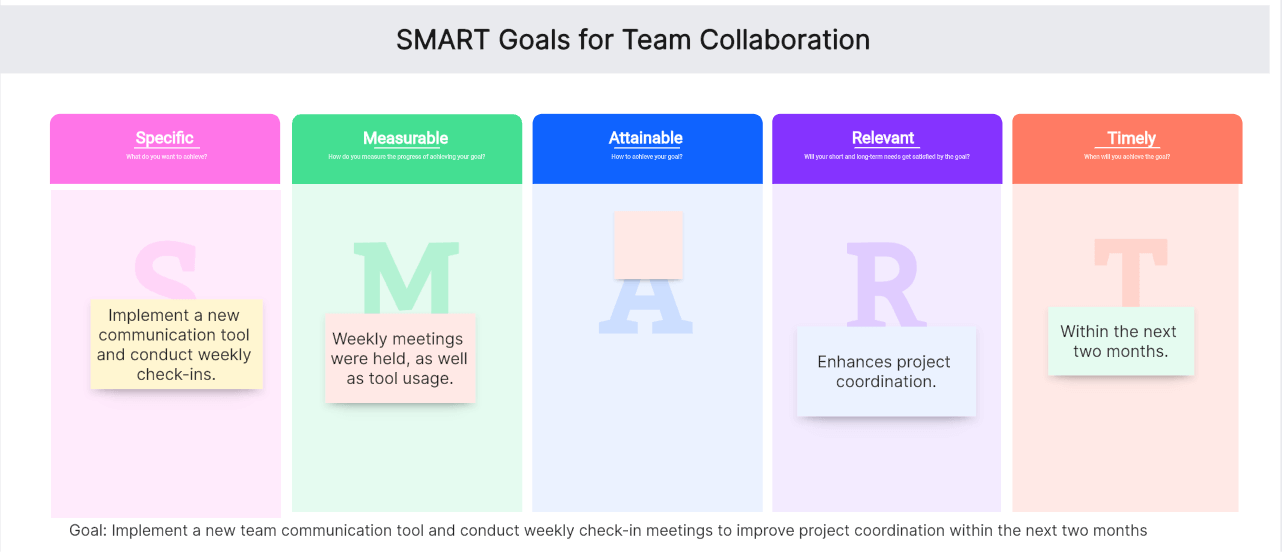
Goal: "Implement a new team communication tool and conduct weekly check-in meetings to improve project coordination within the next two months."
Specific: Implement a new communication tool and conduct weekly check-ins.
Measurable: Weekly meetings were held, as well as tool usage.
Achievable: The tool is available and meetings can be scheduled.
Relevant: Enhances project coordination.
Time-bound: Within the next two months.
5. Career Advancement
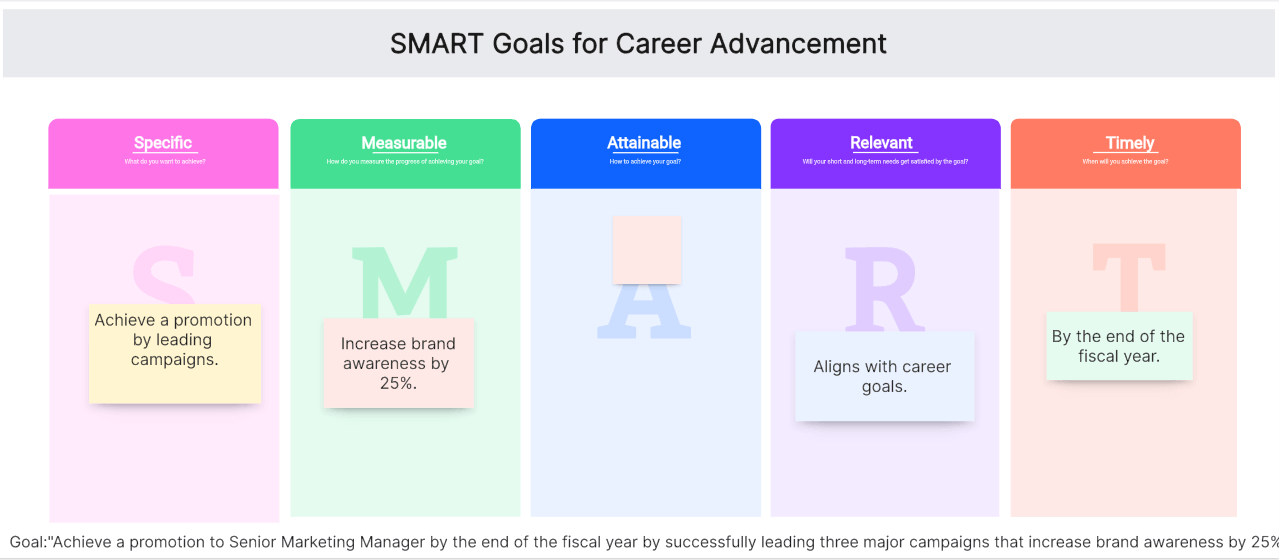
Goal: "Achieve a promotion to Senior Marketing Manager by the end of the fiscal year by successfully leading three major campaigns that increase brand awareness by 25%."
Specific: Achieve a promotion by leading campaigns.
Measurable: Increase brand awareness by 25%.
Achievable: With current resources and strategic planning.
Relevant: Aligns with career goals.
Time-bound: By the end of the fiscal year.
6. Customer Service Improvement

Goal: "Reduce average customer support resolution time from 48 hours to 24 hours by the end of the quarter through staff training and improved ticketing system."
Specific: Reduce support resolution time.
Measurable: From 48 hours to 24 hours.
Achievable: Through training and system improvements.
Relevant: Enhances customer satisfaction.
Time-bound: By the end of the quarter.
7. Sales Performance
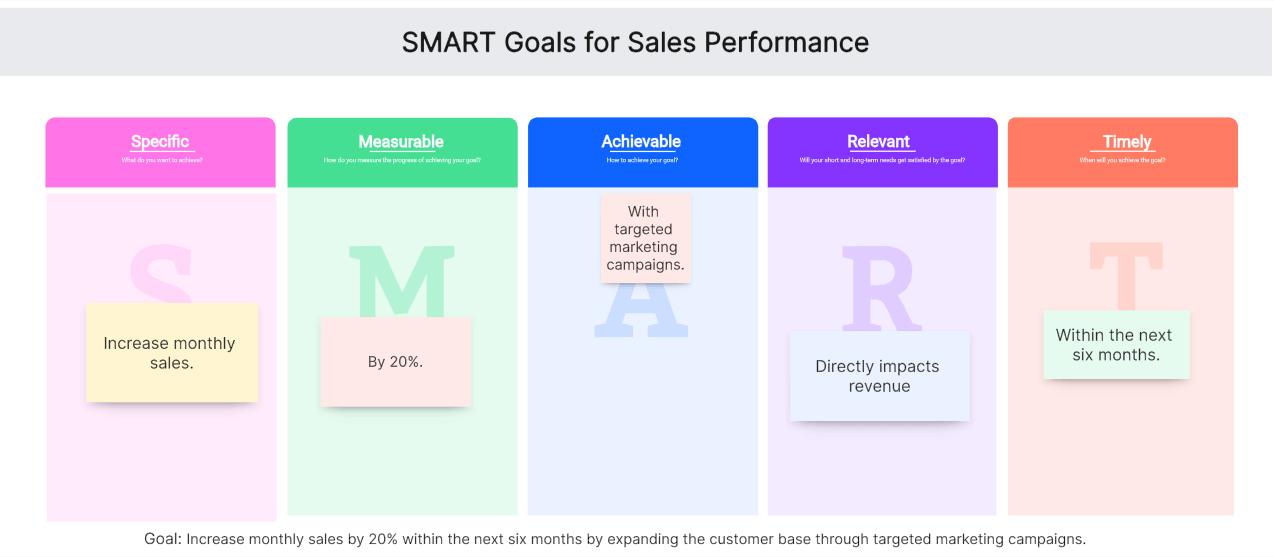
Goal: "Increase monthly sales by 20% within the next six months by expanding the customer base through targeted marketing campaigns."
Specific: Increase monthly sales.
Measurable: By 20%.
Achievable: With targeted marketing campaigns.
Relevant: Directly impacts revenue.
Time-bound: Within the next six months.
8. Employee Onboarding
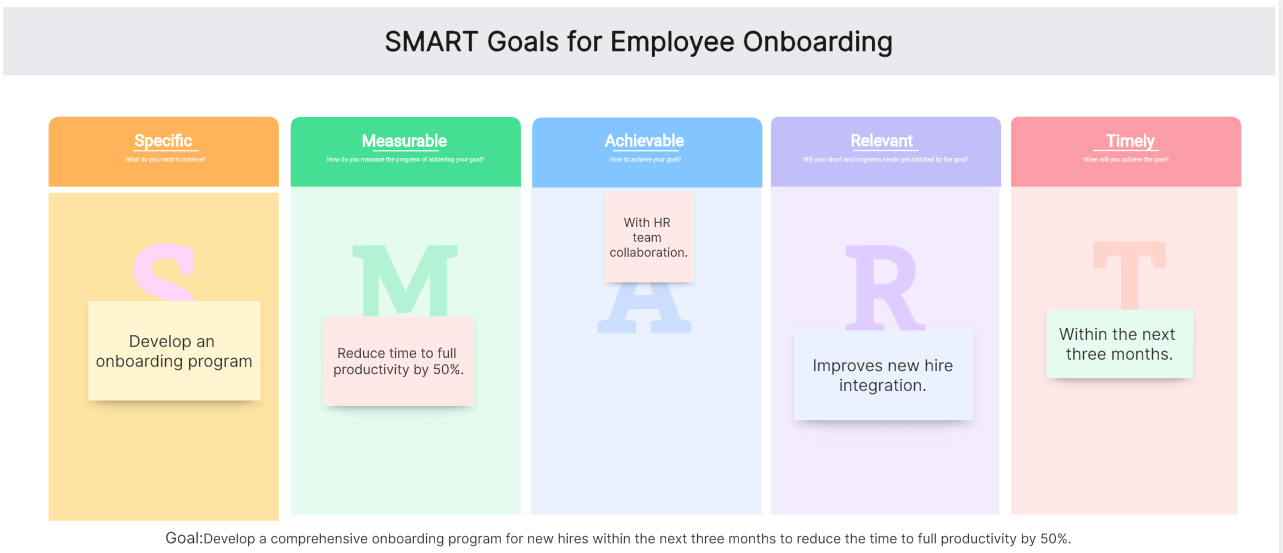
Goal: "Develop a comprehensive onboarding program for new hires within the next three months to reduce the time to full productivity by 50%."
Specific: Develop an onboarding program.
Measurable: Reduce time to full productivity by 50%.
Achievable: With HR team collaboration.
Relevant: Improves new hire integration.
Time-bound: Within the next three months.
9. Operational Efficiency
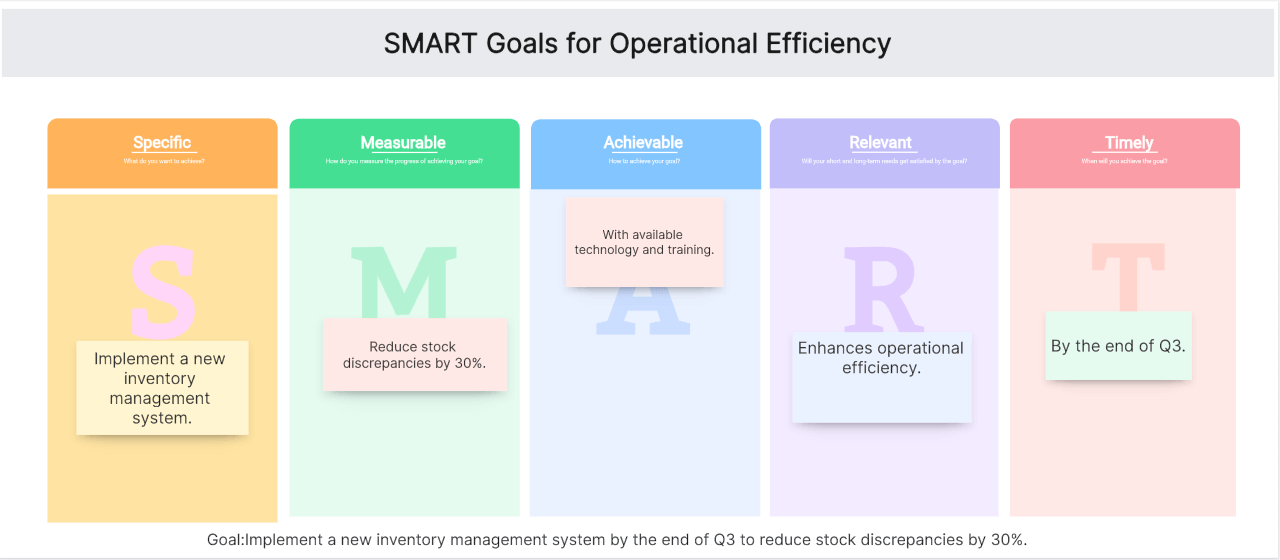
Goal: "Implement a new inventory management system by the end of Q3 to reduce stock discrepancies by 30%."
Specific: Implement a new inventory management system.
Measurable: Reduce stock discrepancies by 30%.
Achievable: With available technology and training.
Relevant: Enhances operational efficiency.
Time-bound: By the end of Q3.
10. Innovation and Creativity
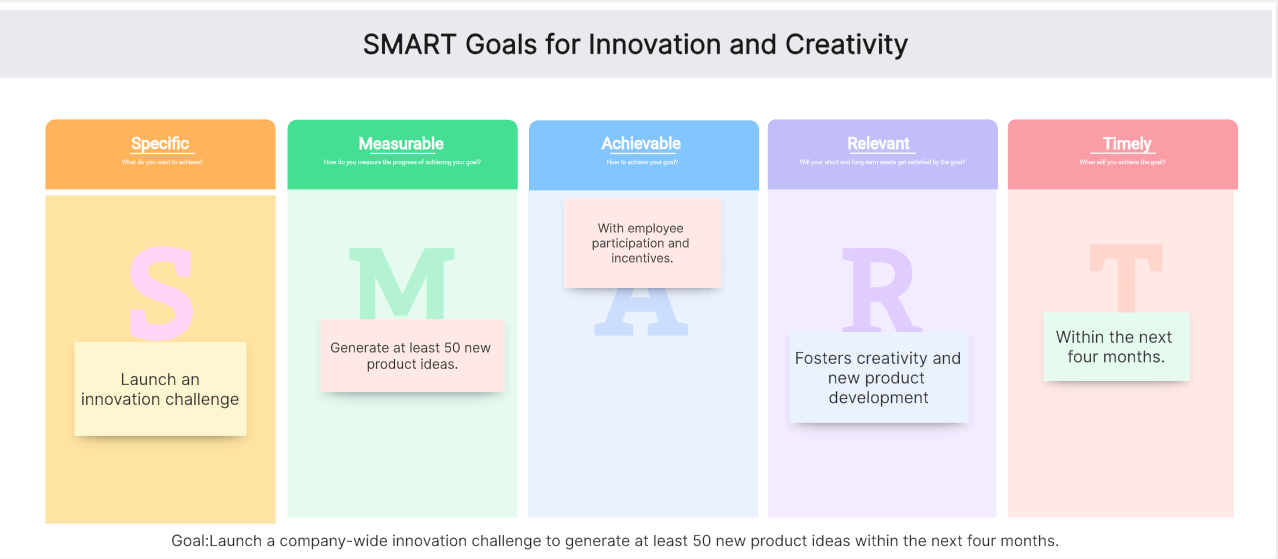
Goal: "Launch a company-wide innovation challenge to generate at least 50 new product ideas within the next four months."
Specific: Launch an innovation challenge.
Measurable: Generate at least 50 new product ideas.
Achievable: With employee participation and incentives.
Relevant: Fosters creativity and new product development.
Time-bound: Within the next four months.
How to Create Effective SMART Goals: A Step-by-Step Guide
Creating effective examples of goals for work involves a strategic approach that ensures your objectives are clear, achievable, and aligned with your broader ambitions. Here is a step-by-step guide to help you formulate and implement SMART goals effectively:
Step 1: Define Your Objective
Clearly articulate what you want to achieve. Be precise about the desired outcome. Start by clearly defining what you want to achieve. The more specific your description is, the better your chances of getting accurate information. A vague goal like "I want to lose weight" can be made more specific by saying "I want to lose 15 pounds in 3 months."
Step 2: Make it Measurable
Determine how you will measure progress and success. Use quantitative metrics where possible. Define the metrics you will use to track progress and establish a baseline to measure improvement against.
Step 3: Ensure Achievability
Assess whether the goal is realistic given your resources and constraints. Set challenging yet attainable targets. Evaluate your current capabilities and resources, and set a goal that is ambitious but feasible.
Step 4: Ensure Relevance
Align the goal with broader organizational objectives or personal career aspirations. Such as "increasing website traffic supports the company’s goal of improving online presence and lead generation." Ensuring the goal aligns with larger business or personal objectives, and confirming that achieving this goal will provide meaningful benefits.
Step 5: Set a Time Frame
Specify when the goal should be achieved. This creates a sense of urgency and helps in planning. You can set a deadline for achieving the goal, and break down the timeline into smaller milestones if needed.
Practical Application with Boardmix
Using tools like Boardmix can further enhance the process of setting and tracking examples of goals for work. Here’s how you can utilize Boardmix to streamline goal-setting and monitoring:
Step-by-Step Guide to Using Boardmix for SMART Goals examples:
1. Select a Template
When you create an account or log in to your existing Boardmix. You can choose a SMART goal template from the Boardmix library. Templates help structure your goals according to the SMART criteria.
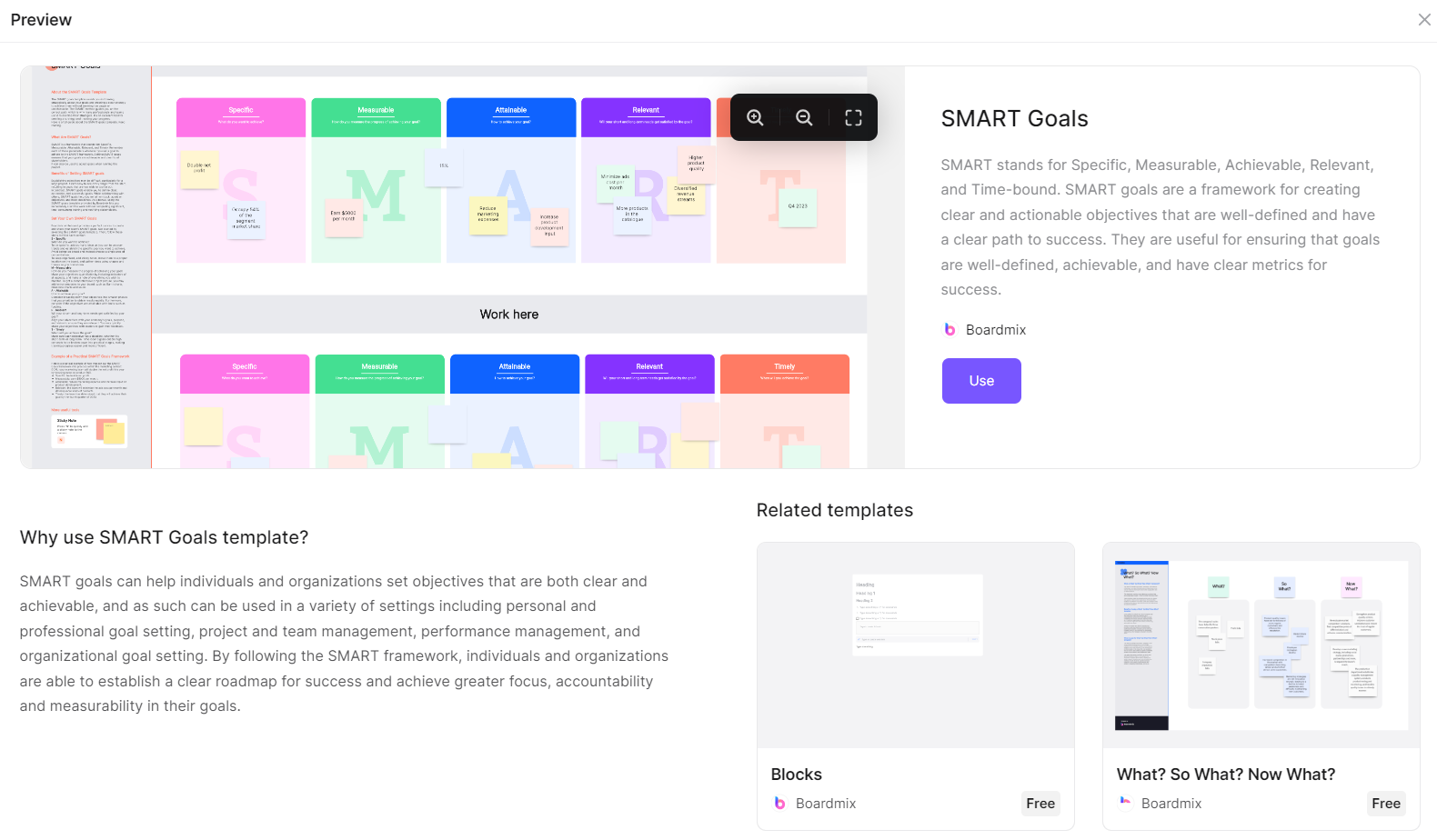
2. Customize Your Goals
Enter your specific, measurable, achievable, relevant, and time-bound goals into the template.
Example: For increasing website traffic, you might input, "Increase website traffic by 20% in four months."
3. Set Milestones
Define key milestones and deadlines within the Boardmix tool, and users can use Boardmix’s dashboard to monitor their progress regularly.
Example: "Achieve a 5% increase in the first month, 10% in the second month, etc."
4. Adjust as Needed
Be flexible and adjust your strategies if you’re not meeting your targets. Boardmix allows for easy modification of goals and timelines. You also can share the goals with your friends and listen to suggestions to adjust the content.
Example: If you’re behind schedule, reassess your strategies and update the plan.
5. Celebrate Milestones
Recognize and celebrate achievements along the way. This keeps you motivated and reinforces positive behavior.
Example: When you hit a 10% increase milestone, celebrate with the team to maintain motivation.
Measuring and Tracking SMART Goals
Achieving your SMART goals requires not only careful planning and execution but also diligent measurement and tracking. Here are strategies and tools to help you monitor progress and ensure that you stay on course to meet your objectives.
1. Establish Key Performance Indicators (KPIs)
Key Performance Indicators (KPIs) are specific metrics that help you measure the progress towards your goal. Each SMART goal should have associated KPIs.
Specific: KPIs should directly relate to the specific aspects of your goal.
Measurable: KPIs need to be quantifiable.
Achievable: Ensure that the KPIs are realistic.
Relevant: KPIs should be aligned with the overall objectives.
Time-bound: Track KPIs within a set timeframe.
2. Utilize Tools for Tracking
Effective tracking involves using various tools and software to monitor your progress. Here are some recommended tools:
Boardmix:
Use Boardmix’s templates to set up and track SMART goals.
Visualize progress with charts and dashboards.
Collaborate with team members in real time.
3. Set Regular Check-Ins and Reviews
Regular check-ins and reviews are crucial for staying on track. These sessions can be weekly, bi-weekly, or monthly, depending on the goal’s timeframe.
Weekly Check-Ins:
Review progress towards KPIs.
Identify any obstacles and adjust strategies.
Update your Boardmix dashboard with new data.
Monthly Reviews:
Conduct a more detailed analysis of progress.
Compare current performance with milestones.
Reassess and adjust the timeline or approach if necessary.
4. Adjust Strategies Based on Data
Be prepared to adjust your strategies based on the data you collect. If you find that you are not on track to meet your goal, consider the following steps:
Identify Issues: Analyze the data to identify any issues or bottlenecks.
Adjust Tactics: Modify your approach or tactics to address these issues.
Reallocate Resources: If necessary, reallocate resources to areas that need more attention.
Update Goals: If significant changes are needed, update your SMART goals to reflect new strategies or timelines.
5. Celebrate Milestones and Achievements
Recognize and celebrate when you hit milestones or achieve your goals. This not only keeps you motivated but also reinforces positive behavior and progress.
Milestone Celebrations: Acknowledge and reward smaller achievements along the way.
Goal Achievement: Celebrate the successful completion of your SMART goals.
6. Document and Reflect
Documenting your progress and reflecting on your experiences is essential for continuous improvement.
Track Progress: Maintain detailed records of your progress, adjustments, and outcomes.
Reflect: At the end of the goal period, reflect on what worked well and what didn’t.
Learn: Use these insights to improve future goal-setting and execution.
Example: Keep a journal or log in to Boardmix where you document weekly progress, challenges faced, and solutions implemented.
Setting SMART goals is a proven method to enhance productivity, achieve professional growth, and propel your career forward. By making your goals specific, measurable, achievable, relevant, and time-bound, you create a clear roadmap to success. Utilizing tools like Boardmix can further streamline the process, ensuring that you stay organized, motivated, and on track. Start setting your SMART goals today and take the first step towards achieving your career aspirations.









